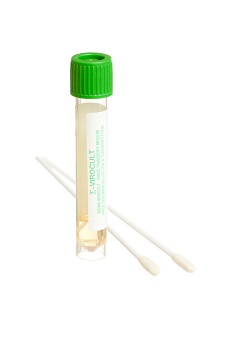Suitable Specimen Types
- Sputum
- BAL
- Trap
- NPA
- BAL
- Trap
- Nose and Throat Swab
- Throat Swab
Turnaround Time
3 daysSample Stability
Stored for 6 monthsRespiratory Viruses PCR
General Information
The following tests are included for all patients Respiratory Syncytial Virus (RSV), Influenza A, Influenza B, Parainfluenza virus, Rhinovirus, Human Metapneumovirus, Adenovirus and Covid (SARS-Cov2). Immunocompromised patients, Neonates and patients on ITU/HDU will have the following additional tests Herpes simplex (HSV), Cytomegalovirus (CMV) and Varicella zoster virus (VZV)
Patient Preparation
For general aspects of taking respiratory samples we recommend that users follow either their local protocols or “The Royal Marsden Manual of Clinical Nursing Procedures”.
Sputum
- Ask patient to take three deep breaths in through their nose, exhale through pursed lips and then force a deep cough. Ask patient to expectorate into a 20ml white top sterile sample container.
Bronchoalveolar Lavage (BAL)
- BAL should be collected according to local protocols using sterile fluids as the instillate. Recovered lavage fluid should be aseptically transferred to a 20ml white top sterile sample container
Nasopharyngeal Aspirate (NPA)
- NPA should be collected according to local protocols using sterile fluids as the instillate. Recovered mucus/fluid should sent in a 20ml white top sterile sample container or other well sealed sterile container.
Nasopharyngeal wash: vacuum-assisted (trap) aspirate method
- Nasopharyngeal wash should be collected according to local protocols using sterile fluids as the instillate. Recovered mucus/fluid should sent in a 20ml white top sterile sample container or other well sealed sterile container.
Nose and throat swabs for virology / molecular tests
Use a green topped virology transport medium kit (labelled as Green Top Sigma-VIROCULT swab).
Throat: Ask patient to sit upright facing a strong light, tilt head backwards, open mouth and stick out tongue. Depress tongue with a spatula. Ask patient to say ‘Ah’. Quickly but gently roll the swab over the tonsils and posterior pharynx
Nose: Ask patient to tilt head backwards. Insert swab inside the anterior nares with the tip directed upwards and gently rotate.
- Place the swab(s) in the transport liquid and snap off the swab shaft at the score line so it fits into the sample pot. Close the cap tightly and label with patient information. Label as “nose”, “throat” or “nose and throat”
Notes
Please indicate if patient is immunocompromised. Significant results telephoned. If Avian Flu is suspected contact Duty Virologist immediately. Please note that we are able to test for Oseltamivir resistance only on request of the Consultant Virologist
Specifications
- EQA Scheme?: Yes
- EQA Status: QCMD & H5 Influenza EQA
